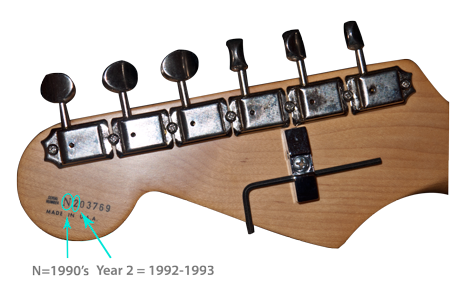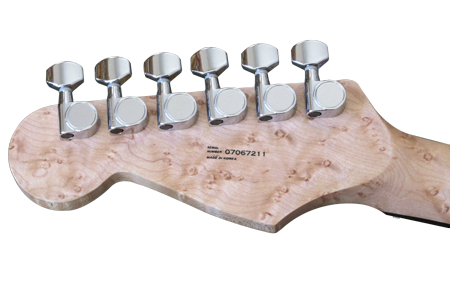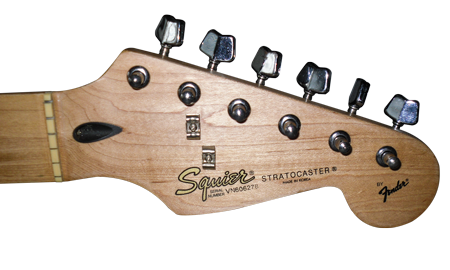Tips to help you accurately date your Fender Japan guitar...
First, you want to determine whether your guitar is from the JV, SQ, MIJ or CIJ series.
Q: What's the difference and how can you tell?
A: The serial number of your guitar will begin with one of the above lettering sequences. Fender Japan used
all of the above lettering sequences for the serial numbering of their guitars and basses over the years, and
knowing this first will help you determine the year of manufacture. These stamps can be found in different
locations on your guitar, so now I'll tell you where you need to look to find these markings...
JV... acronym for 'Japan Vintage' On these guitars you will find the letters 'JV' stamped/engraved into the
neck plate of the Stratocasters and bass guitars and on the bridges of the Telecasters and other guitar
models. There will be 5 numbers also engraved after the 'JV' lettering. Fender 'JV' guitars were only
made from 1982 to 1984. On early Fender JV models, you will also find 'MADE IN JAPAN' written very
small under the Fender spaghetti logo on the headstock of the guitar. On later Fender JV models, the
'MADE IN JAPAN' can be found on the heel of the guitar neck, just above the metal neck plate. All
Fender JV models had the serial numbers engraved into either the neck plate or bridge. Many also have
penciled neck dates (6-14-82) you can only see when the neck is removed from the body of the guitar.
SQ... acronym for 'Squier' These models were made by a different division of Fender and bear the Squier logo
and not the Fender logo. These models have the serial numbering and markings in the same location as
Fender JV guitars, and were made only during the years 1983 to 1984.
MIJ... acronym for 'MADE IN JAPAN' These models spanned the years from 1984 to 1997. You will find the
MADE IN JAPAN stamp on the heel of every guitar's neck, without variation. On Stratocasters and bass
guitars, you will find the serial number just below this stamp, also on the heel of the neck. On Telecasters
and certain other models, you will find the serial number on the bridge. The serial numbers will start with
a letter that corresponds to specific years of production. My chart will help you determine those specifics.
You will not find the MADE IN JAPAN stamp on the headstocks of Fender MIJ guitars.
CIJ... acronym for 'CRAFTED IN JAPAN' These guitars were made from 1997 and are still being manufactured
today. They follow the same serial numbering patterns as the Fender MIJ models.
Please refer to the chart I have provided below in order to pinpoint the exact year your guitar was manufactured...



First, you want to determine whether your guitar is from the JV, SQ, MIJ or CIJ series.
Q: What's the difference and how can you tell?
A: The serial number of your guitar will begin with one of the above lettering sequences. Fender Japan used
all of the above lettering sequences for the serial numbering of their guitars and basses over the years, and
knowing this first will help you determine the year of manufacture. These stamps can be found in different
locations on your guitar, so now I'll tell you where you need to look to find these markings...
JV... acronym for 'Japan Vintage' On these guitars you will find the letters 'JV' stamped/engraved into the
neck plate of the Stratocasters and bass guitars and on the bridges of the Telecasters and other guitar
models. There will be 5 numbers also engraved after the 'JV' lettering. Fender 'JV' guitars were only
made from 1982 to 1984. On early Fender JV models, you will also find 'MADE IN JAPAN' written very
small under the Fender spaghetti logo on the headstock of the guitar. On later Fender JV models, the
'MADE IN JAPAN' can be found on the heel of the guitar neck, just above the metal neck plate. All
Fender JV models had the serial numbers engraved into either the neck plate or bridge. Many also have
penciled neck dates (6-14-82) you can only see when the neck is removed from the body of the guitar.
SQ... acronym for 'Squier' These models were made by a different division of Fender and bear the Squier logo
and not the Fender logo. These models have the serial numbering and markings in the same location as
Fender JV guitars, and were made only during the years 1983 to 1984.
MIJ... acronym for 'MADE IN JAPAN' These models spanned the years from 1984 to 1997. You will find the
MADE IN JAPAN stamp on the heel of every guitar's neck, without variation. On Stratocasters and bass
guitars, you will find the serial number just below this stamp, also on the heel of the neck. On Telecasters
and certain other models, you will find the serial number on the bridge. The serial numbers will start with
a letter that corresponds to specific years of production. My chart will help you determine those specifics.
You will not find the MADE IN JAPAN stamp on the headstocks of Fender MIJ guitars.
CIJ... acronym for 'CRAFTED IN JAPAN' These guitars were made from 1997 and are still being manufactured
today. They follow the same serial numbering patterns as the Fender MIJ models.
Please refer to the chart I have provided below in order to pinpoint the exact year your guitar was manufactured...

Hey Gents, I have a 1998 CY serial number black on black strat with maple neck. Thinking about selling it but can't find any info, listing or past sale prices on eBay or Reverb. Squier Strat - help decode the serial number. The headstock says 'Squier by Fender' Back has a. Find great deals on eBay for fender guitars serial numbers fender serial number. Squier ST JV Serial 1984 Electric Guitar made. Dec 30, 2011 Help With Decoding A Serial Number. Discussion in 'Squier Stratocasters' started by mrlinguini, Dec 29, 2011.


Fender Squier Serial Numbers China
| Fender-Squier history in short Jerome Bonaparte Squier and his son Victor Carroll Squier, two English immigrants who started a violin building and repair company in Boston in 1881. In 1890 Victor opened a store in Battle Creek, Michigan and a short time later a violin factory at 427 Capital Ave SW. (V.C. Squier Company). Violin, banjo and guitar strings were also produced here. In the early 1950s the company also started making strings for the electric guitars of Leo Fender and became in 1963 an official supplier for Fender Electric Instruments. In 1965, shortly before the acquisition of Fender by CBS, Fender purchased V.C. Squier Company. Before the Fender Squier line of guitars was introduced in 1982, Fender made cheaper guitars such as the Fender Lead series at its plant in Fullerton, California. Until the introduction of the Fender Squier series, Fender had never produced low-priced guitars based on the Stratocaster and Telecaster models. He had always used different model designs for the cheaper models. | In the late 1970s and early 1980s, Fender was faced with competition from cheaper Japanese guitars. Japanese labor and production costs were much lower than in America, and to compete with, Fender moved the cheaper Fender guitar production from America to Japan. Sales in Japan were disappointing, Fender could not compete with Japanese competitors such as Tökai and Greco. Fender started negotiations with various Japanese distributors of musical instruments and reached an agreement with Yamano Gakki and Kanda Shokai to found Fender Japan. One of the conditions of the agreement was that Kanda Shokai stops producing its own Greco Fender guitars. Negotiations with Tökai were interrupted and FujiGen Gakki was chosen. The first Squier models appeared in August 1982. Over time, the Squier series has slowly evolved and contains original model designs. The production has also been moved from Japan to various other Asian countries such as Korea, China, Indonesia and India. Victor Carroll Squier |